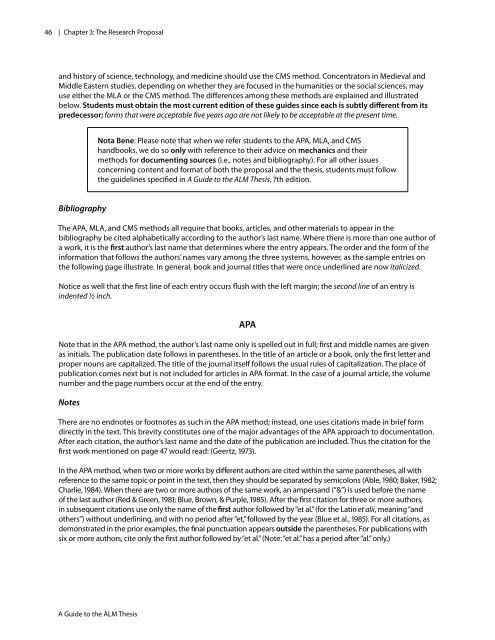A Guide to the ALM Thesis - iSites - Harvard University
A Guide to the ALM Thesis - iSites - Harvard University
A Guide to the ALM Thesis - iSites - Harvard University
You also want an ePaper? Increase the reach of your titles
YUMPU automatically turns print PDFs into web optimized ePapers that Google loves.
46<br />
| Chapter 3: The Research Proposal<br />
and his<strong>to</strong>ry of science, technology, and medicine should use <strong>the</strong> CMS method. Concentra<strong>to</strong>rs in Medieval and<br />
Middle Eastern studies, depending on whe<strong>the</strong>r <strong>the</strong>y are focused in <strong>the</strong> humanities or <strong>the</strong> social sciences, may<br />
use ei<strong>the</strong>r <strong>the</strong> MLA or <strong>the</strong> CMS method. The differences among <strong>the</strong>se methods are explained and illustrated<br />
below. Students must obtain <strong>the</strong> most current edition of <strong>the</strong>se guides since each is subtly different from its<br />
predecessor; forms that were acceptable five years ago are not likely <strong>to</strong> be acceptable at <strong>the</strong> present time.<br />
Nota Bene: Please note that when we refer students <strong>to</strong> <strong>the</strong> APA, MLA, and CMS<br />
handbooks, we do so only with reference <strong>to</strong> <strong>the</strong>ir advice on mechanics and <strong>the</strong>ir<br />
methods for documenting sources (i.e., notes and bibliography). For all o<strong>the</strong>r issues<br />
concerning content and format of both <strong>the</strong> proposal and <strong>the</strong> <strong>the</strong>sis, students must follow<br />
<strong>the</strong> guidelines specified in A <strong>Guide</strong> <strong>to</strong> <strong>the</strong> <strong>ALM</strong> <strong>Thesis</strong>, 7th edition.<br />
Bibliography<br />
The APA, MLA, and CMS methods all require that books, articles, and o<strong>the</strong>r materials <strong>to</strong> appear in <strong>the</strong><br />
bibliography be cited alphabetically according <strong>to</strong> <strong>the</strong> author’s last name. Where <strong>the</strong>re is more than one author of<br />
a work, it is <strong>the</strong> first author’s last name that determines where <strong>the</strong> entry appears. The order and <strong>the</strong> form of <strong>the</strong><br />
information that follows <strong>the</strong> authors’ names vary among <strong>the</strong> three systems, however, as <strong>the</strong> sample entries on<br />
<strong>the</strong> following page illustrate. In general, book and journal titles that were once underlined are now italicized.<br />
Notice as well that <strong>the</strong> first line of each entry occurs flush with <strong>the</strong> left margin; <strong>the</strong> second line of an entry is<br />
indented ½ inch.<br />
APA<br />
Note that in <strong>the</strong> APA method, <strong>the</strong> author’s last name only is spelled out in full; first and middle names are given<br />
as initials. The publication date follows in paren<strong>the</strong>ses. In <strong>the</strong> title of an article or a book, only <strong>the</strong> first letter and<br />
proper nouns are capitalized. The title of <strong>the</strong> journal itself follows <strong>the</strong> usual rules of capitalization. The place of<br />
publication comes next but is not included for articles in APA format. In <strong>the</strong> case of a journal article, <strong>the</strong> volume<br />
number and <strong>the</strong> page numbers occur at <strong>the</strong> end of <strong>the</strong> entry.<br />
Notes<br />
There are no endnotes or footnotes as such in <strong>the</strong> APA method; instead, one uses citations made in brief form<br />
directly in <strong>the</strong> text. This brevity constitutes one of <strong>the</strong> major advantages of <strong>the</strong> APA approach <strong>to</strong> documentation.<br />
After each citation, <strong>the</strong> author’s last name and <strong>the</strong> date of <strong>the</strong> publication are included. Thus <strong>the</strong> citation for <strong>the</strong><br />
first work mentioned on page 47 would read: (Geertz, 1973).<br />
In <strong>the</strong> APA method, when two or more works by different authors are cited within <strong>the</strong> same paren<strong>the</strong>ses, all with<br />
reference <strong>to</strong> <strong>the</strong> same <strong>to</strong>pic or point in <strong>the</strong> text, <strong>the</strong>n <strong>the</strong>y should be separated by semicolons (Able, 1980; Baker, 1982;<br />
Charlie, 1984). When <strong>the</strong>re are two or more authors of <strong>the</strong> same work, an ampersand (“&”) is used before <strong>the</strong> name<br />
of <strong>the</strong> last author (Red & Green, 1981; Blue, Brown, & Purple, 1985). After <strong>the</strong> first citation for three or more authors,<br />
in subsequent citations use only <strong>the</strong> name of <strong>the</strong> first author followed by “et al.” (for <strong>the</strong> Latin et alii, meaning “and<br />
o<strong>the</strong>rs”) without underlining, and with no period after “et,” followed by <strong>the</strong> year (Blue et al., 1985). For all citations, as<br />
demonstrated in <strong>the</strong> prior examples, <strong>the</strong> final punctuation appears outside <strong>the</strong> paren<strong>the</strong>ses. For publications with<br />
six or more authors, cite only <strong>the</strong> first author followed by “et al.” (Note: “et al.” has a period after “al.” only.)<br />
A <strong>Guide</strong> <strong>to</strong> <strong>the</strong> <strong>ALM</strong> <strong>Thesis</strong>

















